



Presented by Satellite Educators Association
And Sponsored by

What is "Satellites & Education?"
Opening & Welcome
See presentation videos, download slides & handouts for
Keynote Speakers • Presenters • Exhibitors
View and print...
At-A-Glance Conference Schedule (single sheet PDF)
Full Conference Program (PDF)
So much of what we know about this Earth, our "island home," and our place in it comes from robotic spacecraft with remote sensors orbiting the Earth and traveling to other worlds. The careful engineering, the creative technologies, the scientific discoveries, all employing a mathematical language -- spectacular and awesome advances with additional applications in many other fields of human endeavor. Yet so few teachers and students, indeed the general public, truly know about them and their importance to life today and in the future. The Satellite Educators Association, Inc. (SEA) seeks the education environment to excite students about science, technology, engineering and mathematics (STEM) through space-based technology -- satellites and satellite remote-sensing data. SEA was founded in 1989 by a teacher with a vision and in response to an overwhelmingly positive turn out for the first Satellites & Education Conference. With 35 annual conferences for teachers in its history, SEA continues to communicate updates to its members and support for teachers and students through its education-government-industry connection, the monthly online SEA Newsletter, the SEA Lesson Plan Library, and this Web site.
The 35th annual Satellites & Education Conference, was held July 29-30, 2022, both in-person and online. The conference was hosted by the Charter College of Education at California State University, Los Angeles. Attending teachers received professional development credit.
SEA President Monica Maynard opened the conference at 9:00 AM PDT, and a warm welcome was given by Dr. Cheryl Ney, Dean of the Charter College of Education at California State University, Los Angeles.
Watch video of Conference Opening by President Maynard and Welcome by Dean Ney (6:15)
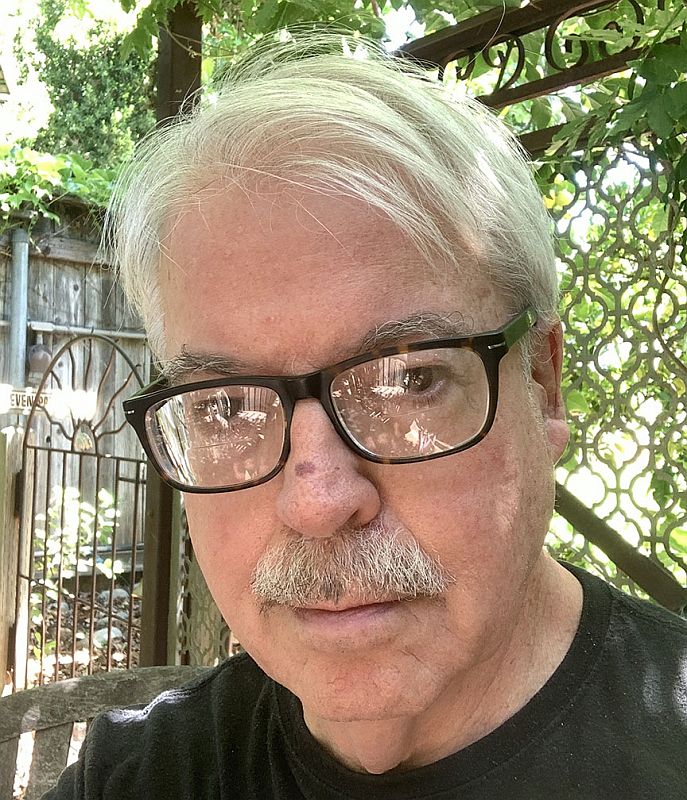
Scientists are almost certain a vast ocean lies beneath Europa’s icy shell. NASA's Europa Clipper spacecraft will perform dozens of close flybys of Jupiter’s moon Europa, gathering detailed measurements to investigate whether the moon could have conditions suitable for life. Europa Clipper is not a life detection mission – its main science goal is to determine whether there are places below Europa’s surface that could support life.
Our speaker, Dave, led real-time flight operations (aka "Mission Control") for the 20-year, multinational Cassini-Huygens Mission in the Saturn system; it ended in 2017. Among Cassini's many discoveries was that Saturn's tiny moon Enceladus turned out to be yet another promising ocean world here in our own solar system. Dave will talk about how Europa Clipper will be conducting a thorough reconnaissance of Jupiter’s ocean world Europa, "Merely half as far away, exploring Europa offers its own set of challenges."
The spacecraft, in orbit around Jupiter, will make nearly 50 flybys of Europa at closest-approach altitudes as low as 16 miles (25 kilometers) above the surface, soaring over a different location during each flyby to scan nearly the entire moon. Europa Clipper will launch in October 2024 and will follow a Mars-Earth Gravity Assist (MEGA) trajectory. The spacecraft will travel for five and half years and arrive at Jupiter in April 2030. The Europa Clipper is NASA’s largest planetary mission spacecraft. With its massive solar arrays and radar antennas, Europa Clipper will be the largest spacecraft NASA has ever developed for a planetary mission. The spacecraft needs large solar arrays to collect enough light for its power needs as it operates in the Jupiter system, which is more than five times as far from the Sun as Earth.
Watch the Opening Keynote Address with Dave Doody (44:43)
View/download presentation slides (PDF, 2.9MB)
Photo credit: Dave Doody

The James Webb Space Telescope (JSWT) is the largest and most complex space telescope NASA has built. The telescope will see the first galaxies forming, will peer through dust to see the birth of planets and stars, and will examine exoplanet atmospheres. The telescope has a 6.5-meter diameter mirror comprised of 18 hexagonal segments and a tennis court size sun shield that keeps the telescope cold at 35 degrees Kelvin. JSWT had 50 major deployments involving the release of 178 pins. The six-month commissioning phase encompassed more than a thousand procedures to align the mirror segments and to verify the 17 instrument modes. The science observations begun in July are a culmination of twenty years of international effort led by NASA. What does it take to achieve this level of optical performance? And how will it be improved by two orders of magnitude for the next 6-meter space telescope that is just starting its twenty-year journey to launch? Extreme optical performance will be required to search for Earth-size exoplanets around nearby stars and to take spectra of those exoplanets to look for biosignatures. The lessons and experience of building JWST move us closer to being able to build a telescope to look for Earth 2.0.
Dr. Morgan earned her MS and PhD in Optical Sciences at the University of Arizona with an emphasis in nulling interferometry for exoplanet direct imaging, and her Bachelor’s in Electrical Engineering from Caltech with an emphasis in remote sensing. She has more than 20 years of experience at JPL, the last seven in the Exoplanet Exploration Program Office as the HabEx large concept study Technologist and as lead of the multi-institutional yield Exoplanet Science-performance Evaluation Team. She has worked extensively with the JPL astrophysics community in various capacities, from proposal work to program and project work, to develop technologies and missions to search for Earth 2.0 and increase our understanding of the universe.
Watch this Keynote Address with Rhonda Morgan (35:19)
Photo credit: Rhonda Morgan
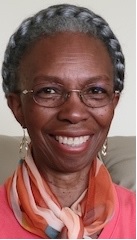
Dr. Shannon holds a BA and MS in Biology and an EdD in Learning and Instruction, Science Education. She recently retired as Director of STEM Education at Synergy Academies. She was the founding principal of Synergy Quantum Academy. Dr. Shannon was an inaugural member of the twelve-person California Teacher Advisory Council providing a voice for STEM educators to discuss trends and policies facing STEM education in California and interface with the State policymaking community.
Dr. Shannon spoke with an invigorating enthusiasm for teaching and how to make better use of the resources discovered this at this conference in order to achieve greater results.
Watch the closing Keynote Address with Barbara Shannon (53:48)
View/download presentation slides (PDF, 173KB)
Photo credit: Barbara Shannon
| Project Nieuwestad: Modeling Exoplanet Habitability with Machine Learning Luke Meier, Ishaan Agrawal, High School Students Winners of the Northwest Science Expo (Washington, Oregon, Idaho) |
| As advancements in space exploration and astronomy have increased dramatically in recent decades, looking to humanity’s future in an extraterrestrial or even an extrasolar context is gradually emerging from science fiction into science fact. Additionally, the pervasive question of "are we alone in the universe?" has driven much data collection on observable exoplanets. Thus, the collection, cataloging, and organization of these planets in the context of habitability is an important field of work within astrophysical research. While these are barely even a measurable percentage of what's out there, impressive thousands of exoplanets have been observed and catalogued. Models and their features in a relevant context present an important question with constantly evolving answers. Our research aimed to combine machine learning and exoplanet databases to model the prospective habitability of these observed exoplanets. In our model construction, we trained a machine-learning algorithm to identify the most important features that make a planet habitable and to identify whether or not a planet is habitable. View/download presentation slides (PDF, 0.8MB) |
| Classroom Activities with the AMSAT Functional CubeSat Simulator Freederick Raab, Educator College of the Desert, California |
| How to engage students with CubeSat operation and transmission of data to Earth? Raab presented the AMSAT CubeSat Simulator. With the simulator, students are able to manage a satellite’s solar power; determine the satellite’s orbital period, orientation, and spin rates; expand mission payloads; utilize radio protocols; and more. |
| The Radio Amateur Corporation (AMSAT) is a non-profit educational organization founded in 1969. For more than 50 years, AMSAT has placed satellites in low Earth orbit enabling voice communications between amateur radio operators. Since 2015, four of those have been CubeSats, and the AMSAT radio designs and protocols for those CubeSats have been adopted by numerous educational CubeSats currently in orbit. |
| AMSAT developed the CubeSat Simulator to provide students with hands-on, classroom experience receiving and interpreting operational telemetry data using the same radio communications methods employed by CubeSats. AMSAT makes simulators and ground stations available for loan to teachers and other educational groups accompanied by instructions for classroom activities. |
| The ground station software enables students to hear, visually observe, and decode many of the radio formats in use today for data exchange, reporting position, and image reception. The station is built around the popular Raspberry Pi single-board computer attached to a small screen displaying data transmitted by an active orbiting AMSAT satellite or the CubeSat Simulator. View/download presentation slides (PDF, 1.3MB) View/download handout (PDF-2 pages, 2.1MB) |
| Earth SySTEM: Using Satellites to Monitor the Earth John Moore, Executive Director, and Maxwell Friedman Institute for Earth Observations, New Jersey |
| The A3Sat Project allows students to build an active model mirroring many aspects of an authentic CubeSat design engineers use for launch into space. |
| A3Sat has been programmed to send data and imagery to a designed ground station replicating collection and transmission of data. The app is a desktop software application, compatible with both macOS and Windows, and is able to communicate and transfer various data through Python socket communication. Students are able to pair the A3Sat and the computer through a WIFI hotspot from the Raspberry Pi, and further control the A3Sat from the app while also viewing real-time environmental data, health data (CPU intensity, etc.), as well as infrared and regular images. Built within the Group Station app are data analysis and visualization tools, such as data plotting of all environmental data, as well as a 3D graph visualization of the altitude/displacement of the A3Sat. Students are able to conduct data analysis while the A3Sat is still in flight, viewing data stream into the app while also being plotted live within. Watch A3Sat video in 2022 NSF-funded Video Showcase (3:01) View/download presentation slides PDF, 0.5MB) |
| Overview of the NASA TechRise Student Challenge Lucas Moxey, Project Manager NASA TechRise |
| Moxey presented an overview of the NASA TechRise Student Challenge, sponsored by NASA's Flight Opportunities Program. This challenge invites teams of 6th to 12th grade students throughout the United States and its territories to engage in hands-on science, technology, engineering, and math (STEM) opportunities. The program empowers students to propose experiment ideas that leverage the use of electronics and microcontrollers, and it offers winning teams an opportunity to fly those experiments on a suborbital flight platform, with the goal of testing their experiments in near-space and/or microgravity (i.e., weightlessness) conditions. |
| As part of the TechRise 2021-2023 challenge, a total of 57 student teams were selected from across the nation to participate. Each winning team was awarded a $1,500 prize, a customized flight hardware enclosure, engineering and buildup support, as well as a flight test on either a high-altitude balloon or a rocket-powered suborbital vehicle. The current student experiments span a wide variety of technology areas and applications. Watch video of presentation (41:57) View/download presentation slides (PDF, 0.8MB) View/download presentation handout (PDF-1 page, 0.74MB |
| Making Math Accessible Joan Horvath, Rich Cameron, Co-Founders Nonscriptum |
| 3D printing is a natural fit to teaching many subjects, most notably math, engineering and other STEM subjects. Horvath and Cameron are the authors of many popular books about 3D printing and its classroom applications, including MAKE: Geometry and the upcoming MAKE: Calculus. They have also developed geometry curriculum modules for teachers of visually impaired students. Join them to hear about the opportunities and barriers for 3D printing for students in K-12, universities, and special education. Watch video of presentation (28:50) View/download presentation handout (PDF-1 page, 1.3MB) |
| NGSS + Satellite Imagery + Motivation = Success Ed Murashie, President ProEngineered Solutions |
| Satellite imagery can be the tool to implement the Next Generation Science Standards in kindergarten through high school. But how do you learn about satellite imagery and where can you find it? This presentation, of course! |
| Murashie showed us how to learn about satellites with hands-on demonstrations using live satellite reception. Participants walked away with lesson plans and other online references. Watch video of presentation (47:46) Watch video of receiving station in operation (16:53) View/download presentation slides (PDF, 2.8MB) |
| CubeSat Mission: Human Impacts on the Planet Monica Maynard, STEM Coordinator The Aerospace Corporation |
| Participants will engage in a team competition in which they collaborate to find and save the Tardigrade (water bear) and bring it back to Earth. Competitors will explore several regions of Mars and complete space related tasks designed to keep everyone learning while having fun. |
| In this video, find an explanation of a learning game for ZOOM or face-to-face classroom, experience a demonstration of the game on ZOOM, and hear reactions and further explanation via follow up Q&A. Watch video of presentation (53:37) View/download presentation slides (PPSX-with embedded video, 10.5MB) |
| Earth Station Lab: An Educational Computer Application Using Satellite Remote-Sensing Data Steve Mills, Director PolymathGeo |
| Earth Station Lab (ESLab) is a web-based application that has been developed by Polymath Geo (PG) and the CSUN Center for Geospatial Science and Technology (CGST). It is intended as a lab component of Earth science curricula. It links Geographic Information Systems (GIS) and Virtual Learning Environment (VLE) software, and uses government produced satellite remote sensing data as a part of Project-Based Learning curricula. The VLE has separate interfaces for students and teachers. ESLab uses the WISE VLE application developed with NSF funds at UC Berkeley. Satellites produce vast quantities of data made available to the public, but the volume of the data and the complexity of GIS makes it difficult for teachers and students to use within a classroom setting. ESLab simplifies this process so that this technology can be a part of any classroom. |
| In 2021, PG and CGST developed a simple to use data conduit application that connects with the big satellite databases of NASA, NOAA, and other federal agencies and converts these data into slippy maps compatible with OpenLayers. Called Earth Station Link (ESLink), it is designed to allow teachers to download local and timely data that is relevant to their own lesson units. ESLink ensures that teachers do not need to complete an exhaustive search of the agency portals or convert the data into a usable format on their own. As part of this presentation, ESLab and ESLink were demonstrated including a high school lesson unit on the ENSO. Watch video of presentation (60:02) View/download presentation slides (PDF-without animation, 1.9MB) View/download presentation slides (PPSX-with 2 animations, 26.1MB) |
| Learning Math Through the People Who Lived It Robert Black, Author |
| Author and engineer Robert Black returned to the Satellites & Education Conference with his newly-completed biography series for teens, The Mathematical Lives. Developed over the past five years, the six volumes introduce readers to some of history's most important mathematicians and the problems they worked on. Each book even gives readers the chance to work the actual historical problems themselves. In this presentation, author Robert Black revealed the themes behind the series, exploring how our understanding of math has changed, and how that understanding has changed us. He also recounted how the Satellites & Education Conference helped with the development of the series, and of his mathematically-themed writing in general. Watch video of presentation (56:13) View/download presentation slides (PDF-without animation, 1.7MB) View/download presentation slides (PPSX-with animations, 36MB) |
| Mapping Mars Dominique Evans-Bye, Educator Clark Magnet High School, California |
| Students at any level can enjoy exploring Mars and mapping its topography. This presentation introduced Mars viewers from NASA, fun activities to hook students' attention, and mapping activities using ArcGIS Online, JMARS and ArcGIS Pro. |
| A story map was shared that has links and instructions to complete each of the activities presented. |
| Mapping Mars is part of a quarter unit of GIS & Remote Sensing at Clark Magnet High School. It is an extension of the Mars Student Imaging Project developed by Arizona State University (http://marsed.asu.edu/msip). Watch video of presentation |
Since 1988, this conference's unique Exhibit Hall has showcased organizations and vendors bringing you services and materials supporting students and teachers. The hybrid format of the 2022 conference offered exhibitors several options. For example, Adriana Le Compte opted to present NASA DEVELOP in a face-to-face 15-minute segment during the conference while sharing in-person exhibit space at the NASA booth; Steve Mills opted to describe his Earth Station Lab in a full plenary session presentation via ZOOM; many utilized table and booth space in the in-person Exhibit Hall.
You are invited to join me for a walk around Cal State LA's Golden Eagle Ballroom as I visit each in-person exhibitor. To orient ourselves, the central area of the ballroom has well-spaced tables and chairs for in-person attendance at each presentation. The speaker's podium is in the front of the ballroom. The "exhibit hall" is arranged around the perimeter of the ballroom. We will begin our walk nearest the podium and travel counter-clockwise around the exhibit hall.
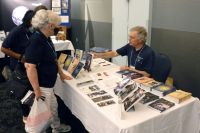
Here we find our good friend, and SEA member, Bob Black. A quality control engineer by day and author by night, Bob shares an impressive display of his mathematically-themed books including the latest biographical series for teens, The Mathematical Lives. Bob's writing focuses on the important contribution of each book's subject presented in such a way that even the most "math-shy" are enticed toward understanding. His award-winning books are well-researched and well-written. Each is an unexpectedly engaging read.
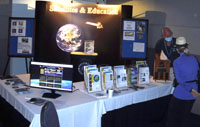
This non-profit organization was established in 1989 as a professional society to promote the innovative use of satellite technology in education and disseminate information internationally to all members. It is the driving force behind more than three decades of Satellites & Education Conferences. Staffing the booth is my close friend and long-time colleague Duane Laursen, retired high school science teacher and SEA Life member. Duane offers a wide selection of handouts resources and demonstration access to the Association's Web site, SatEd.org, featuring the SEA Lesson Plan Library and SEA Newsletter. He is always ready to talk with visitors and offer helpful ideas where he can.
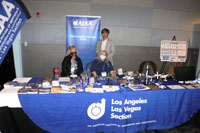
AIAA has been an integral supporter of the Satellites & Education Conference since the early 1990s when the conference was held in Pennsylvania. Today, members of this local section, especially Ken Lui (independent consultant), Sheri Stukes (software systems engineer, JPL), and Jeff Puschell (Raytheon Technologies; SEA Vice-President) provide unparalleled support in producing this conference. Ken and Sheri staff the the booth offering the most intriguing variety of "toys" that demonstrate and teach engineering concepts in addition to many educational resources. Both are ready to talk with visitors about all that AIAA has to offer teachers.
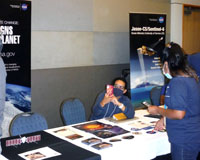
NASA Jet Propulsion Laboratory, managed by California Institute of Technology, is NASA's lead center for robotic exploration of the solar system. Long-time friend and SEA Life member Annie Richardson welcomes us to the NASA booth. For many years, Annie, an Education Outreach Specialist at JPL, arranged magnificent tours of JPL for the M.Y. S.P.A.C.E. Teams that included opportunities to meet and hear presentations from scientists whose areas informed the annual M.Y S.P.A.C.E. research theme. Friendly, outgoing, and supportive, Annie is assisted this year by Erica Carcelen and Adriana Le Compte of NASA DEVELOP.
DEVELOP is part of NASA's Applied Sciences Capacity Building Program. It addresses environmental and public safety policy issues by conducting interdisciplinary feasibility projects that apply the lens of NASA Earth Observations to community concerns around the globe. Bridging the gap between NASA Earth Science and society, DEVELOP builds capacity in both participants and partner organizations to better prepare them to address the challenges that face our society and future generations.
Watch video of exhibit presentation (9:50)
View/download presentation slides (PDF, 1.44MB)
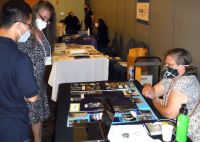
Several years ago, Linda Sciaroni, teacher at Firebaugh High School in Lynwood, California, engaged Educational Passages to help her students build a 7-foot sail boat. The boat, dubbed "Fledgling Freddy," was equipped with two tracking systems, camera, temperature sensors, GPS, and tilt meters. The boat has been "sailing" in the Pacific Gyre (aka "the garbage patch") for more than 250 days sending regular data from its remote sensors. Linda showed us maps of the boat's journey and discussed the project and findings thus far. Linda selected this more relaxed and friendly method of communication rather than a full plenary session presentation.

Here we find Steve La Dochy, Cal State LA Professor Emeritus from the College of Natural and Social Sciences. Steve, too, is a long-time supporter of the Satellites & Education Conference and once served as SEA Membership Chair. He is active in the local AMS chapter and brings a variety of resource links and printed materials for visitors to glean and utilize. Steve offered me a book on meteorology, sort of a beginner's volume, published by AMS Project Atmosphere. This small volume is so comprehensive, yet so very clearly written, I wished I had a class set for my high school students before I retired. AMS offers so many educational resources and training opportunities for teachers, and Steve is always ready to help where he can. Thanks, Steve.
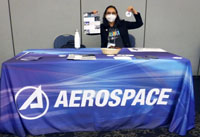
Monica Maynard is a remarkable and very busy Teacher on Special Assignment in Montebello, California, as well as a Life member of SEA. Yet she finds time to serve as SEA President and as the STEM Coordinator for The Aerospace Corporation. With a friendly smile, Monica tells us of the long-standing Aerospace commitment to education. She offers access for both teachers and high school students to events, research, facilities, and resources providing real-world examples of problems and solutions. Monica has been a steadfast exhibitor and regular presenter at Satellites & Education Conferences for nearly a decade. Through Monica, we have also benefited from the expertise of numerous, informative and interesting speakers.
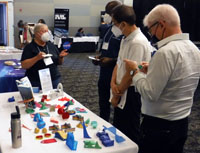
Our last stop around the exhibit hall is Nonscriptum where Joan Horvath and Rich Cameron offer visitors a quick look at one of the most innovative and helpful set of tools for teaching math. Joan and Rich used 3D printing to design and build hands-on working and static models of mathematical functions and concepts. These visual and tactile tools bring alive what might otherwise seem difficult math to some. Applicable to literally all students including those with sight or other challenges, these devices are clearly explained in a series of how-to books. All you need is access to a 3D printer and imagination.
That's the Satellites & Education Conference Exhibit Hall this year. Thank you for joining me on this walk around to meet these extraordinary and inventive people.
SEA is grateful to all the supporting exhibitors for sharing themselves with you during Satellites & Education Conference XXXV. Our exhibitors would love to hear from you with questions and requests for more information. Their contact information can be found in the Conference Program.
Exhibitor photos from: Pete Arvedson
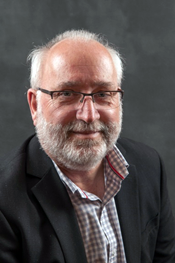
John has been active of SEA since the early 1990s. He has been a regular presenter at Satellites & Education Conferences in both Pennsylvania and Los Angeles. Throughout three decades, John has served SEA in a variety of capacities. He was one of the first M.Y. S.P.A.C.E. teachers, helped coordinate the M.Y. S.P.A.C.E. Team student report, served as SEA President, recruited and mentored several M.Y. S.P.A.C.E. teachers. Most importantly, John authors the "John's Journey" article appearing in nearly every issue of the SEA Newsletter since 2013.
When John first joined SEA he was a teacher at Burlington County Institute of Technology (high school) in New Jersey. In retirement, John began work for the Burlington County Bridges Commission as director of student activities at Palmyra Cove Nature Park, parkland surrounding the New Jersey foot of the Tacony-Palmyra Bridge over the Delaware River just northeast of Philadelphia. Over several years, he developed there an Institute for Earth Observations providing experiential opportunities for K-12 students (and teachers) emphasizing satellite-related science and engineering. He now serves as Executive Director of the Institute. John has been active in Region III of the National Earth Science Teachers Association and a long-time member and education advocate in the American Meteorological Society. He has been a tireless advocate of the G.L.O.B.E. Program. He was selected and served as an Albert Einstein Distinguished Educator Fellow for the U.S. Department of Energy where he promoted policies related to satellites in education to members of Congress.
The Vic Everett Memorial Service Award is given to SEA members of good character who have demonstrated excellence in service to the Satellite Educators Association and others by helping promote the vision and mission of the organization inside and outside of SEA events and assisting in preparation and delivery of SEA programs. The SEA Service Award is named in memory of Victor Lee Everett, long-time member and tireless volunteer worker for the Satellite Educators Association. Learn more about Vic HERE.
Active SEA members can nominate deserving individuals online. The nominations are reviewed by an ad hoc nominating committee, and the final selection is made by the Executive Committee (elected officers). The award recipient is honored during the annual Satellites & Education Conference.
Congratulations, John!
Photo credit: John Moore
The Satellite Educators Association wishes to express its deepest gratitude to the many supporters of Satellites & Education Conference XXXV without whom there would not be a conference. Most are mentioned above. Three, however, deserve special recognition: the Paul London and the Volunteer Staff, Dean Cheryl Ney and Cal State LA's Charter College of Education, host for this conference since 2002, and Raytheon Technologies who have provided speakers, presenters, and support without other recognition during the conference. Please join SEA in thanking...

The volunteer staff is the heart of the Satellites & Education Conference. Since the beginning of the Satellites & Education Conference in 1988, the volunteer staff has been the backbone on whom the conference was presented. The volunteers help set up and take down conference venues, operate the registration arena, answer questions, direct traffic, and generally do whatever is asked of them to help make your conference experience smoother and more enjoyable. Volunteer Coordinator Paul London, himself a volunteer, works tirelessly behind the scenes for weeks before the conference to schedule the volunteer staff, then meets with, trains, supervises and sets them to their tasks when the conference arrives. Those volunteering for staff are asked to commit at least 8 hours of service as a staffer at the conference. In return they receive full access to the conference without charge. Most of the volunteer staff are Cal State LA students although anyone can sign up. Special thanks to Paul and the entire Volunteer Staff for Satellites & Education Conference XXXV for a job well done!
For more about this and other conferences and activities of the Satellite Educators Association, please visit https://SatEd.org.